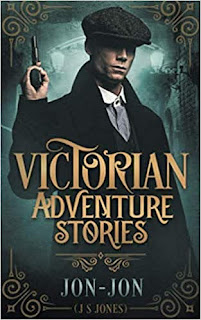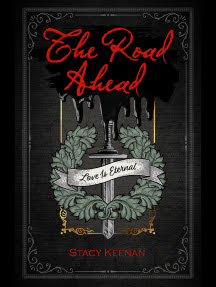Weekly Reader: Victorian Adventure Stories by Jon Stephen Jones; Nostalgic Adventurous Fun Set In The Victorian Era
By Julie Sara Porter
Bookworm Reviews
Spoilers: Question: Are you a fan of the old 19th century Adventure Novels written by Jules Verne, Robert Louis Stevenson, and H.G. Wells? Do you like the mysteries featuring characters like Sherlock Holmes, A.J. Raffles, Arsene Lupin, and Fantomas? Do you dream in Steampunk? Does your preferred style of reading end in the 20th century before Realism and psychological motivation became the thing? Do you read just to embrace a good adventurous escape? Then look no further than Jon Stephen Jones' Victorian Adventure Stories.
This anthology is exactly what it says on the tin and in some ways that's what makes it good. The stories are predictable, but exciting. They are entertaining and fun. When a Reader is under stress sometimes it's good to kick back with an old fashioned adventure yarn and Jones provides that.
The best stories are:
"Henchman"
Most of the stories stand on their own but there are some plots that carry over into multiple stories. "Henchman" is the first of three stories that feature The Medics, a ruthless gang that rules London's Underworld and are headed by the mysterious Dreaded Doctor, an unidentified figure who has had some medical training which they put to good use when taking apart an enemy or a stool pigeon (and might be that other frightening unidentified Victorian medico, Jack the Ripper.).
The trouble starts when John Felmersham, a Medic operative, has decided that he has had enough of gang life and wants to resign. Unfortunately, the Medics don't exactly take rejection well. As John struggles to escape from his former employers, they use various intimidation tactics such as death threats on windows and stalkers following him from train station to train station.
The story has its share of tension since John never knows who is in the Medics, so much of the suspense lies in the fact that anyone that he meets could be a potential threat. One of the more interesting twists is the revelation of the Dreaded Doctor's true identity. While in the context of the story, the twist is obvious, the implications and back story behind this character and how they became the Dreaded Doctor are rather fascinating to imagine. The Dreaded Doctor takes an older story and gives it a more modern outlook.
"A Hebridean Adventure"
If "Henchman" is a tribute to the crime stories for Arthur Conan Doyle, then this story is a tribute to Doyle's other well known work, The Lost World with a lot of Jules Verne thrown in. It is also the other plot that carries over into multiple stories in this anthology.
Professor James Bedford accompanies his colleague, Giles, and several others to a mysterious island near the Outer Hebrides. Of course the island is filled with prehistoric creatures that scare the daylights out of our plucky scientists and adventurers.
"A Hebridean Adventure" is one of the definite tributes to the old adventure novels in writing style and characterization. The band of scientists are the typical characters that would be found in such an adventure of the time period. There is the cynical first person narrator, the enthusiastic science expert who cares more about exploration than the cost of human life, the assistants that provide their expertise to the expedition, and the working class muscle. We even have the bratty kid whose involvement causes more harm than good (and in this case whose actions carry over into another story, "The Great Exhibit." I told you the Outer Hebrides Island carries over into other stories.) Characterization takes a back side to action and adventure just like in the real life books and stories of the era.
In fact the only real modern touch in this story is that the dinosaurs have feathers, keeping with modern paleontological research that has shown that dinosaurs may have had them as potential evidence of their subsequent evolution into birds.
The reason that this one is one of my favorites is because it is such a pastiche of the writing of the era, that it could have been written then. While "Henchman" takes centuries old ideas and gives them unique modern twists, "A Hebridean Adventure" is firmly stuck in the past and that is part of the antiquated fun.
"The Magic Circle"
You know the fairy stories where some poor mortal gets invited to share a drink or a dance with the Fair Folk only to return from the party to find that centuries have passed? "The Magic Circle" takes these old fairy legends and transports them to the Victorian Era. Geoffrey and Edward, two drunken Victorian gents, take a spooky ride on the London Underground. No one else is on the train nor is anyone driving. Things get weirder when they encounter a very short man who politely offers them a drink.
Jones clearly has a lot of fun visualizing a fairy land that has gone Industrial like its human counterparts. The legendary creatures have their own station in which they dub the "real London Underground," a station where they lure unwary travelers. The drinks are now offered in pubs and stands rather than in a court setting. The Little Man that speaks to Geoffrey and Edward could be mistaken for the average London train goer of the day. It's an interesting twist when most fantasies write Faeries as still living in an agrarian Medieval in appearance society, that some author modernize them.. Jones writes the magical creatures as capable of modernizing their culture and using human's styles and inventions against them.
The other interesting aspect to this story is that it's a tribute to the London Underground System and was meant to correspond with the 150th anniversary. Jones reveals how much the system has changed over the centuries and how it's still a part of London daily life.
"The Box"
Let's see we have criminal gangs, dinosaurs, and fairies. Why not a story that pays tribute to the con artist and Gentleman Thief, that charming lying conniving bane of law enforcement's existence as popularized by characters such as Maurice Leblanc's Arsene Lupin and E.W. Hornung's A.J. Raffles (the latter of whom was created by none other than Doyle's brother in law)? "The Box" is a clever game of one-upship as the various characters seek to outdo and outsmart each other.
Gordon is upset because his box containing a precious treasure is missing. He recruits various people including Bill, the station attendant, Arthur, a gentleman, and Marcus and Wayne, a pair of rough Cockney men go on the search for the box. Each one hopes to hoard the treasure for himself or at least for a financial reward.
The story is brilliant as the characters attempt to outdo each other and find the box. Bill and Co's seemingly altruistic desire to help Gordon is definitely put aside for financial gain.
However the thieves are themselves outsmarted when Gordon reveals himself to be much smarter and more cunning than they are. Two plot twists come into play revealing a clear winner in this battle of wits.
"Next of Kin"
Who doesn't love a good ghost story? The Victorians certainly did as evidenced by works like A Christmas Carol, The Woman in White, and many short stories such as the ones that I reviewed in the anthology Women's Weird.
Terrence storms into the home of his friend, John terrified. He has been haunted by a poltergeist. Concerned for his friend's health and sanity, John goes to Terrence's house to confront the ghost. An apparition threatens to frighten Terrence to death.
John tries various means to get rid of the ghost from engaging in friendly conversation, finding out why it's still on Earth, to physically fighting him. As a last resort, John has to call in a relief player: another ghost with a familiar tie to the duo.
The resolution is sweet compared to the creepy actions previously that shows that even death can't stop true friendship and loyalty.
"To Stay or Not To Tay"
This story mixes fact with fiction by using a real life tragedy as a backdrop for the fictional happenings. The Tay Bridge Disaster happened on December 28, 1879 during a violent storm. The first Tay Rail Bridge collapsed as a train passed over it, killing all aboard.
This disaster is graphically described as a married couple take a fateful ride on the train to flee for their lives.
"To Stay or Not To Tay" calls back in many ways to the first story, "Henchman." Once again we find someone escaping via train from the dastardly Medics and their leader, the Dreaded Doctor. (Unfortunately, even though we now know the identity of the Doc, they don't make a personal appearance in this story and are only name dropped a couple of times. It's rather disappointing since in the first story, the Doctor made a very effective and brilliant antagonist.)
This time married couple, Lionel and Anne Spadwick are the unfortunate targets for an umm unscheduled surgery after Lionel steals from the gang.
While the story is similar to "Henchman" in the increased paranoia that they are being followed, the biggest issues aren't from the Medics themselves but from the elements and faulty construction. This story shows that no matter how people act, there will always be events that are completely out of their control. Sometimes, Fate doesn't care what you have done or are planning to do when it has other ideas.
Despite the gravitas of Jones' writing in depicting the disaster and the enormous loss of life, there is a clever line that actually draws on some of the other stories suggesting that all of the stories in the anthology are tied together.
Sometimes you want a book that is deep in thought and analysis. Sometimes you want a book that is pure escapist adventure. Victorian Adventure Stories is the latter and that's what makes it fun.







